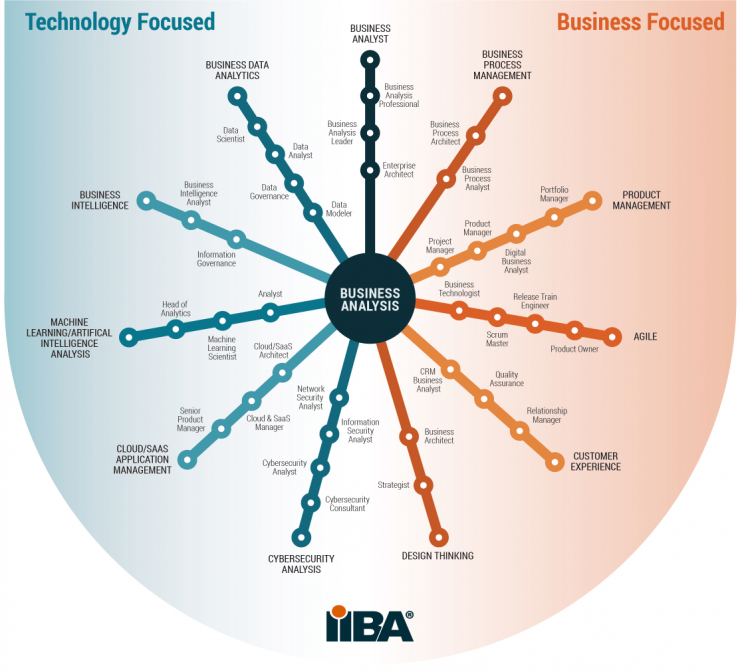The business analyst position has been quite popular in recent years.
However, do we all have the same understanding of what is hidden under both names?
Have you ever wondered what it would be like to design a system without an analyst? Does the analyst help or harm the project? What exactly is a business analyst responsible for in an IT project?
I will try to answer these difficult questions and invite you to take a different look at the role of the business analyst and the importance of the business analysis in a software development process.
Business analyst – present and future
During the REQUEST (Request for innovation) conference in 2018, prof. SGH Andrzej Sobczak presented analyses of people’s substitutability by machines in various business activity areas. The position of the business analyst was then and is not threatened – yes, the analysts will support themselves with robots and use machine learning in their daily work, but their most important work tool will still be they themselves, their skills, knowledge and experience.
Currently, the business analyst is associated with two roles – data analysis and analysis of business changes in the organization’s environment. But this is only the tip of the skills set for people who work in this position. The number of roles and the scope of responsibilities fulfilled by the analyst are clearly shown in the graphics created by IIBA (International Institute of Business Analysis:
In line with the proposed division into technology or business orientation, two BA specializations have emerged. Each person in this position has an enormous sea of opportunities to make the best use of their opportunities and development in both areas.
But do we want to artificially demarcate roles for BA? My position is that a good business analyst should know each area. During meetings with production, clients, internal business, suppliers, sponsors, project managers… (you can keep multiplying 🙂), the analyst has to get along with everyone!
What helps in being a business analyst?
Subjective skills decalogue for BA is as follows:
- Openness to changes.
- Goal orientation.
- Active listening.
- The thirst for knowledge.
- Communicativeness
- Focus on details.
- Analytical thinking.
- Noticing relations between events.
- Visionary ideas.
- Firmness.
Regarding the above, and still a very subjective catalogue of skills useful in the analyst’s work, for me the most important thing is openness to changes and noticing relations between events (elements, business units, business objects) – this is the driving force for the analyst. Every project, no matter how big or small, results from the need or necessity to make some kind of change in the organization. I do not want to enter the field of change management process here, but it is worth mentioning one of the principles of change management – changes are introduced by people. And people need effective tools to conduct analysis. In this article, I propose to find out about proven methods that really help in the daily work of the business analyst in a project.
FIT & GAP analysis
In IT companies that produce software based on the analysis of business needs – functional and non-functional – the business analysis stage and the analyst’s participation are necessary, and the analyst has several useful tools at his disposal, which are supported in everyday work.
In the case of projects based on the use of reusable system components or finished products, it is necessary to conduct a fit analysis and deficiency detection, i.e. fit&gap. The essence of this type of analysis is an in-depth understanding of the client’s needs in order to verify the possibility of using ready-made solutions and identify areas requiring implementation.
The key element of the fit&gap analysis is identification of functional and non-functional business requirements and creation of an integration model taking into account the new system. The participation of the system’s business recipients and architects is a must have during workshops with suppliers/development teams that will adapt the system to given business needs.
RTM
RTM = Requirements Traceability Matrix
Another effective tool in the analyst’s work during the project is a map of connections in order to track the coverage of business requirements for the functionalities performed. The main benefit is that all functional and non-functional requirements are defined and mapped to the completed/planned system components.
The use of a simple tool – an excel file is enough if we do not have dedicated applications at hand – allows you to control the progress of work in the project.
Traceability matrix is also used for tracking interactions between functionalities for software testers. Thanks to the map of connections, the tester gains a broader view of the system and relations between requirements, which gives him a comprehensive understanding of business needs.
If we exchange a map of relationships with the client or project sponsors, then they gain a tool to track the progress of work and the degree of scope implementation.
Event storming
In previous publications on the blog, I mention event storming, but let me refer to this method of collecting requirements once again.
Event storming focuses on getting all people involved in creating/expanding the system to know the business domain, so participation is required from:
- Business people who know the business needs best,
- Technical people who know the business domain and are able to map business requirements to the system,
- A person who knows the event storming method and will conduct the workshop in accordance with its principles.
A workshop during which the system is broken down into small parts and events affecting the functioning of the business domain are diagnosed, often lasts several hours/days and requires the full involvement of all participants. The results of the analysis are most often recorded on cards, which are then arranged into sets of requirements describing a given functionality.
The main benefit of event storming is getting to know all the events that occur between the system and its users and the interactions between other systems outside the organization. Additionally, we gain:
- Better understanding of the business domain,
- Levelled off knowledge on the technical and business side,
- Common language and nomenclature of business needs,
- Integration of people involved in the project.
Regarding integration, nowadays the question arises: Is online integration effective? In the case of on-line workshops, during event storming sessions, let’s give ourselves more time to explain behaviours and business needs. It is also helpful to use applications that will allow each participant to arrange their virtual “cards” into collections, and then eliminate repeated events during a joint discussion. The discussion during event storming is the most important part and sometimes it can be very dynamic – according to the proverb: ‘what doesn’t kill us makes us stronger’ 🙂
Best practice
What to choose? Is only one method the best?
Well… in this case there are no perfect solutions. 🙂 Every organization is different and needs different ways of extracting business knowledge to create the best-suited solutions. In fact, I recommend that you use every available and proven method of analysis so that people involved in the project have a comprehensive view of the business domain.
How does the business analyst fit in with all of this? Like a fish to water! Each method allows them to thoroughly understand the needs and possibilities, gives them control over the course of processes and allows them to study the interaction between the user and the system.
What does the business ultimately receive? A system tailored to its needs, integrated with the business domain of the entire organization and better understanding of it.
Joanna Skawińska
At VSoft S.A., Joanna deals with functional analysis as well as the development and adaptation of IT tools to business needs in the financial area, in particular monitoring and debt collection. She has been gaining knowledge in the area of monitoring and debt collection since 2005, based on her experience in managing processes and teams responsible for monitoring and debt collection for, among others, Bank BPH S.A., Bank Pekao S.A., Alior Bank S.A., SGB-Bank S.A.




